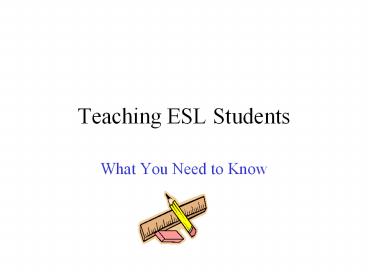Teaching ESL Students - PowerPoint PPT Presentation
1 / 20
Title:
Teaching ESL Students
Description:
Teaching ESL Students What You Need to Know What is ELL The state of Tennessee defines ELL students as: Those whose native language is other than English and whose ... – PowerPoint PPT presentation
Number of Views:1396
Avg rating:3.0/5.0
Title: Teaching ESL Students
1
Teaching ESL Students
- What You Need to Know
2
What is ELL
- The state of Tennessee defines ELL students as
- Those whose native language is other than English
and whose difficulty in speaking, reading,
writing, or understanding the English language is
an obstacle in classrooms where English is the
only language of instruction.
3
Whats in a Name?
- ESL English as a Second Language
- ELL English Language Learner
- ESOL English as a Second or Other Language
- ELD English Language Development
- LEP Limited English Proficiency
- FEP Fluent English Proficient
4
Identifying ELL Students
- The way teachers and administrators can identify
ELL students is by administering the Home Survey
with the following questions - What is the first language your child learned to
speak? - What language does your child speak most often
outside of school? - What language does your child speak most often
inside the home?
5
Assessment Identifying current ESL Level
- Students must be given the CELLA (Comprehensive
English Language Assessment) to identify their
current ELL level.
- Levels are determined by scores on the CELLA
test. - There are three areas of assessment
- 1. Oral/Speaking Listening
- 2. Reading
- 3. Writing
6
Placement based on scores (Grades K 2)
7
Placement Continued (Grades 3 - 5)
8
Placement Continued (Grades 6 8)
9
Placement Continued (9 12)
10
Yearly ESL Testing with ELDA
- Every ESL student must be tested every year to
establish ESL level, growth, and yearly progress. - Tennessee State currently uses the ELDA to
determine students reading, writing, listening,
and speaking level for ESL students.
- Testing out of ESL is determined the ELDA
results, and two other sources of documentation
proving students proficiency. - Students must score a 4 to be considered eligible
for promotion with two additional sources. - If a score of a 5 is obtained students may exit
with confirmations of grade level proficiency
with one other source of documentation.
11
What is T1 and T2
- When a student has passed the ELDA with a 4 or 5
they are classified as T1 and exit the ESL
program to be monitored by the district for the
first year of transition. - A T2 is if the student is successful for the year
as a T1 the district must continue to monitor
them for one more school year. - When a T2 is successful in the regular classroom
without ESL support he/she can be reclassified as
a FEP or LEP. - T1 and T2 students are not entitled to any
accommodations/modifications for testing purposes
12
Retention Issues
- ELL students must not be retained in grade level
because of their language skills. - Alternatives to Retention
- 1. Remedial before - and after School programs
- 2. Tutoring
- 3. Summer school
- 4. Instructional Aids, and
- 5. Peer tutoring
13
Accommodation Modifications
14
Role of the Teacher
- Become a student of culture
- Be sensitive to cultural differences
- Promote a multicultural point of view
- Allow students to become students of culture
15
Classroom Support
- Classroom support is crucial for the success of
the ELL student. - Simple and easy to do activities that offer
support could include the following
- Curriculum material that reflect a variety of
cultural groups - Lessons that address different learning styles
and modalities - Visual aides and bilingual resources
- Role modeling/peer grouping
16
Methods of instruction
- Interactive lessons with hands on activities and
cooperative learning - Encouragement of creativity and discovery
- Versatility and flexibility
- Enhancement and support of the mainstream
curriculum - Opportunities for all students to feel successful
17
Parents of ELL students
- The parents of ELL students need support to
- Understand how U.S. school system works
- Understand how local school districts and schools
operate - What is expected of them by schools, districts,
and personnel - Participate in their childs education
18
Things to Remember
- English is not an easy language to learn
- Use a variety of methods and strategies to
support a positive learning environment - Be sensitive to cultural differences
- Provide consistency in classroom regulations and
expectations
19
Resources
- www.educationworld.com
- www.tesol.org
- www.kumc.edu/diversity/
- www.englishclub.com
- www.elearningguild.com/
- http//owl.english.purdue.edu/handouts/esl/eslstud
ent.html
20
Bibliography
- Tennessee English as a Second Language Program
Guide (2003) - State of Tennessee Department of Education
English as a Second Language (ESL) Curriculum
Standards (retrieved January 2005)































